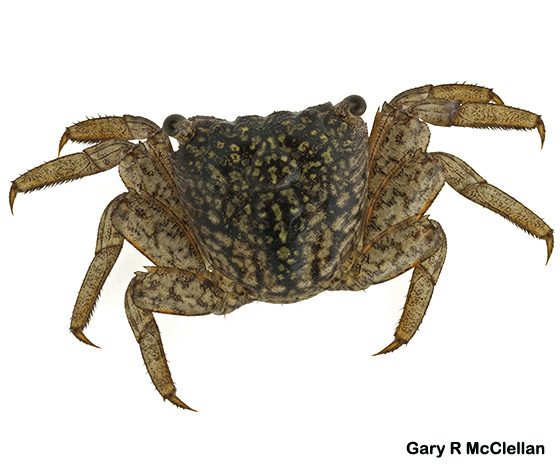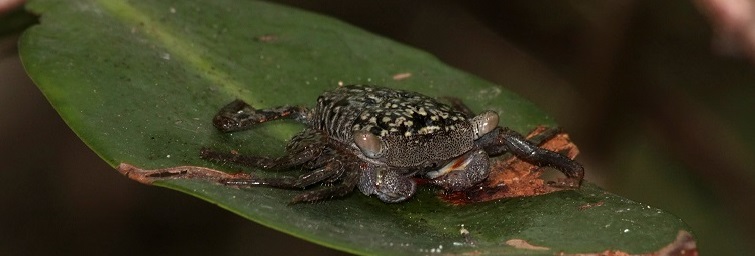Form and Function
The Aratus pisonii, or Mangrove Tree Crab, displays its own unique form and function to benefit its fitness and overall well-being. Aratus pisonii exhibits a brown to dark green carapace in which is most wide at its anterior, and tapers of approaching the posterior end. Its eyes are located on the wide ends in the front corners of the carapace. The crab has brown legs that give support to claws. These claws have black hairs that grow on them. The sharp claw also function to allow the crab to climb into their canopies and other vertical surfaces (Smithsonian, 2009).
Maximum carapace width for the mangrove tree crab is 2.7 centimeters. Average widths vary with gender in adult crabs with males being 2.0 centimeters on average, while females are 1.8 centimeters on average. Salinity is a variable that has a factor on carapace width at maturity. For males, carapace width when mature is 1.6 centimeters, and for females it is 0.9 centimeters. Habitat also influences the size of the tree crab. Large crabs are more common in more mature mangrove forests, while smaller tree crabs can be found most concentrated in stunted mangroves. Food availability and environmental phenomena and conditions are just a few more conditions contributing the size of the mangrove tree crab (Smithsonian, 2009).
The Aratus pisonii, commonly known
as the mangrove tree crab has membrane bound organelles within its
cells, which makes it fall into the Eukaryote domain. Its rear
mounted flagellum make is a member of the Opisthkonta clade.
The tree crab lacks a cell wall, thus making it a member of Kingdom
Animalia. The presence of an exoskeleton, jointed legs and
appendages, bilateral symmetry, and a body divided into distinct
parts, are the synapomorphies of the tree crab that classify it into
the Arthropod phylum (Arizona, 1997). It also falls into the
subphylum of the Crustaceans. The Crustaceans have two body
regions, five or more pairs of legs, two pairs of antennae, and can
live in both terrestrial and aquatic regions (Arizona, 1997).
When further distinguishing the mangrove tree crab, it falls into the Malacostraca class. Being in this class, the tree crab has three main sections including the abdomen, thorax, and the head. The species also has about 19-20 jointed body segments. An open circulatory system is also a characteristic of the tree crab and other species in this class (New Hampshire Public Television, 2014). Its order is Decapoda, which classifies the tree crab as having ten legs, as well as a developed carapace (Decapod Crustaceans, 1999). The distinguishing factor of the tree crabs family, Sesarmidae, is the ability to climb trees in the terrestrial environment (Cumberlidge et al, 2005). Aratus pisonii falls into the genus Aratus and is currently the only species occupying the genus. A characteristic for the species here is the lack of lateral spines on its carapace (Smithsonian, 2009).
Aratus pisonii is very unique in terms of its form. It is the only species in its genus thus meaning there is not a known organism that share most of its characteristics with it. Although it essentially is a crab, it is not what most would describe a crab as because of its average size being 1.8-2.0 centimeters (Smithsonian, 2009).
Go back to the Home page or learn about where this species lives at the Habitat page.
